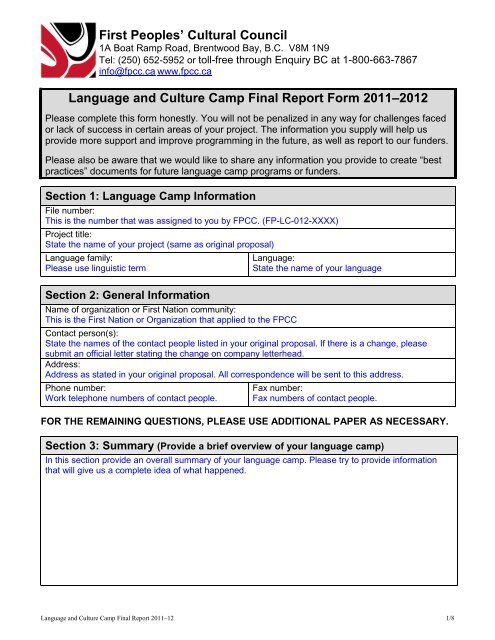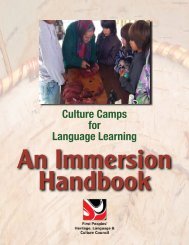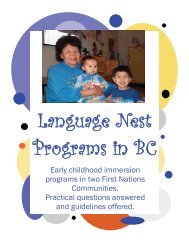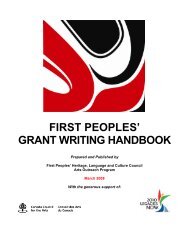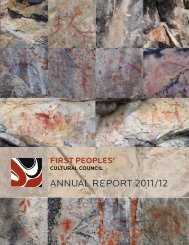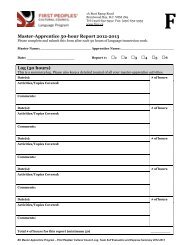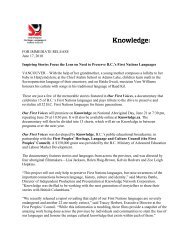Language and Culture Camp Final Report Form ... - First Peoples
Language and Culture Camp Final Report Form ... - First Peoples
Language and Culture Camp Final Report Form ... - First Peoples
You also want an ePaper? Increase the reach of your titles
YUMPU automatically turns print PDFs into web optimized ePapers that Google loves.
Section 4: Participants4a. Target Age Groups of <strong>Language</strong> Learners (students): Indicate the number of learnersfor each target age group in the boxes below.In this section state the numbers of language learners from each approximate age group.Children ( 0 – 12) Youth (13 – 30) Adults (31 – 54) Elders (55+)4b. Community Members Involved: Indicate the number of community members involved incarrying out the camp.In this section state the total numbers of participants for each approximate age group. Include campstaff, Elders, organizers <strong>and</strong> learners.Elders Teachers Staff Other (specify)4c. Organizations <strong>and</strong>/or Communities that Benefited from the <strong>Camp</strong>Name all the organizations that were involved in your project.Example: Elders Centre <strong>and</strong> school district # 764State the number of communities involved in your project. Also provide the names of the communitiesinvolved.4d. Project Participants: Indicate the names of the people involved in the camp. IncludeElders, organizers, instructors, students <strong>and</strong> any others involved.Participant’s NameRole (Elder, teacher, student, etc.)In this section include the names of ALL the participants involved in your camp project. Includeorganizers, staff, Elders, language resource people, language learners etc. Also state each participant’srole in the camp.Use separate pages if necessary.For example:Rosa FrankEdward TomShaylene EdwardsElderCoordinatorYouth language learner<strong>Language</strong> <strong>and</strong> <strong>Culture</strong> <strong>Camp</strong> <strong>Final</strong> <strong>Report</strong> 2011–12 2/8
Section 5: Process <strong>and</strong> Activities5a. Pre-project Preparation <strong>and</strong> Training: Describe the pre-project planning <strong>and</strong> training thatwas carried out, if any.In this section, describe how you prepared for the camp.Include organization meetings, staff training, criminal records checks, orientations, curriculum planningetc.5b. Program Schedule: Indicate the schedule of your camp.State the schedule of your camp. State the months / weeks / days that your camp lasted; also state thetimes of day <strong>and</strong> the season of your camp. Also, if applicable, provide sample daily schedules onseparate pages. For example:Season (if applicable) Months Weeks Days TimesWINTER December 1 7 overnightPlease briefly explain the schedule:This camp was an overnight. Winter camp-out that lasted one week (seven days) in December.5c. Logistics: Describe the logistics of carrying out your camp.Transportation: How was transportation h<strong>and</strong>led?Briefly describe how participants got to <strong>and</strong> from the camp. Was transportation provided to participants?Or, were participants responsible for their own transportation?For example: A school bus <strong>and</strong> driver were contracted to pick up <strong>and</strong> drop off youth participants. Elders<strong>and</strong> organizers were reimbursed for their travel expenses to <strong>and</strong> from the campsite.Meals: Were meals provided? Who prepared the meals?Briefly explain how meals were h<strong>and</strong>led during the camp. If meals were provided to participants, explainhow many, what was served, who prepared them.For example: All meals were provided during the camp. Youth participants <strong>and</strong> the camp cook workedtogether to prepare traditional meals. Breakfast included fruit, cereal <strong>and</strong> toast; lunches included moosestew, bread, salads, <strong>and</strong> fish; dinners included moose tacos, fish, bread, salads <strong>and</strong> smoked fish.On the last day of the camp a traditional feast was held <strong>and</strong> prepared by the camp cook <strong>and</strong>participants.Other:If applicable, in this section provide any other details about logistics such as sleeping arrangements,transportation, food, organization, etc.<strong>Language</strong> <strong>and</strong> <strong>Culture</strong> <strong>Camp</strong> <strong>Final</strong> <strong>Report</strong> 2011–12 3/8
5d. Method of Instruction <strong>and</strong> Lesson Organization: For your language camp you mayhave used different methods of instruction. Please describe how the language was “taught”<strong>and</strong> passed on to the learners.Describe the methods used for transmitting the language to learners.For example: Total Physical Response – actions by learners following oral instructions The Natural Approach – learners <strong>and</strong> fluent speakers conduct daily activities in the language <strong>Language</strong> immersion games in your activities Storytelling, role-playing <strong>and</strong> cultural activities in the languagePlease also include a description of your daily lesson/activity organization. Include samples on aseparate page.5e. Activities <strong>and</strong> Games: Provide a detailed description of the activities, games played, etc.(with instructions).Describe <strong>and</strong> explain all language immersion activities used in your camp.For example:1) Digging cedar roots in the forest near the camp2) Played bone game in the language using traditional songsSection 6: <strong>Camp</strong> Fluency Evaluation6a. Fluency Evaluation: Describe the immersion method you used <strong>and</strong> summarize thesuccess (or lack of success) in improving the language fluency of camp participants. If you didthe camp again, would you choose another method?Explain how participants were immersed in the language, <strong>and</strong> what immersion methods were used.State whether or not the participants’ fluency improved.For example: Used natural daily conversation including common phrases <strong>and</strong> questions for all activities.If you carried out another camp, would you use different method(s)? If yes, what method(s) would youuse?6b. Describe <strong>and</strong> attach assessments of students’ language learning at the camp.Describe how language learners were evaluated on their language learning <strong>and</strong> fluency improvement.In other words, how was their language learning measured?Did you assess fluency by asking learners to demonstrate language learned through directconversation, task completion or h<strong>and</strong>s-on activities?On separate pages, include the results of the language learning assessments.<strong>Language</strong> <strong>and</strong> <strong>Culture</strong> <strong>Camp</strong> <strong>Final</strong> <strong>Report</strong> 2011–12 4/8
Section 7: <strong>Camp</strong> EvaluationProvide an overall evaluation of the language camp. Explain why your camp was successful ornot. Explain what you learned from the project, <strong>and</strong> recommend any improvements orchanges.Note: You will not be penalized in any way if your project faced challenges. We would liketo know about any challenges so that we can provide more support in the future.Provide an OVERALL evaluation of the camp. Generally, what worked <strong>and</strong> what did not work well? Wasthe camp successful in reaching the goals in the original proposal? Why? Why not?Also explain what you learned, <strong>and</strong> how you could improve future camps.7. <strong>Camp</strong> Evaluation continued: Please also include evaluations from each group ofparticipants:In this section include evaluations of the camp from all participants groups. Include what they liked <strong>and</strong>did not like, what they thought was useful or not useful <strong>and</strong> their recommendations. Please useseparate pages if necessary, <strong>and</strong> include original evaluations where applicable.7a. Elders: How did the language camp benefit your community, <strong>and</strong> what recommendationsdo you have to improve future camps?Include evaluations of the camp by Elders. This could be in the form of verbal feedback.7b. Organizers: What worked <strong>and</strong> what didn't work for your camp? What are yourrecommendations for future camps?Include evaluations of the camp by organizers <strong>and</strong> staff. This could be done in team meetings, orindividual surveys.7c. Instructors: What worked <strong>and</strong> what didn't work for your camp? What are yourrecommendations for future camps?If applicable, include instructor evaluations of the camp.7d. Participants: (What was the best/worst part of the camp? Did you learn the language?)Please also attach a sample of pre- <strong>and</strong> post-camp surveys from your participants.Include evaluations of the camp by participants (specifically language learners).Also include samples of pre- <strong>and</strong> post camp surveys on separate pages if applicable.<strong>Language</strong> <strong>and</strong> <strong>Culture</strong> <strong>Camp</strong> <strong>Final</strong> <strong>Report</strong> 2011–12 5/8
Section 8: Recommendations8a. <strong>Camp</strong> Recommendations: Outline recommendations for future camps/programs. Forexample: What were the challenges you faced <strong>and</strong> how did/would you overcome them?Outline <strong>and</strong> explain your recommendations for future camps.How would you improve your camp if you did it again?What challenges did you face <strong>and</strong> how did you overcome them?How would you overcome challenges if you did the camp again?What advice would you give to other communities carrying out similar camps?8b. Funding Recommendations: Outline funding recommendations for futurecamps/programs.Outline <strong>and</strong> explain your funding recommendations for future camps.Was the amount of funding adequate or not?Were the budget criteria too restrictive?What changes would you like to see in how the budget was divided?What advice (with respect to funding) would you give to other communities carrying out similarcamps?Section 9: MaterialsIf applicable, provide a list of materials created <strong>and</strong> include copies of any language materialscreated such as pictures, posters, newsletters, curriculum, fluency evaluations or surveys,videos, DVDs, etc. Also, provide a brief description of the materials.If applicable, list <strong>and</strong> describe all materials created during your project. Also include copies of all thematerials created.For example:MaterialsDescriptionAnimal colouring bookThis book includes outline pictures of animalsfrom our area. Young children can learn thenames of the animals as they color in thepictures.Plants <strong>and</strong> Berries Flash CardsThese cards have colourful pictures of all differentplants <strong>and</strong> berries from our area. Learners canuse them to learn the names of plants <strong>and</strong> berriesused in traditional food preparation.Section 10: Additional Information (optional)Provide any additional information that has not been included in this form so far. It is importantthat you are able to adequately express all of the information about your camp project.If applicable, in this section include any information or details about your camp project that have notbeen addressed in the other sections of this form.<strong>Language</strong> <strong>and</strong> <strong>Culture</strong> <strong>Camp</strong> <strong>Final</strong> <strong>Report</strong> 2011–12 6/8
Section 11: Financial Statement Summary11a. <strong>Language</strong> <strong>and</strong> <strong>Culture</strong> <strong>Camp</strong> Financial <strong>Report</strong>Name of <strong>First</strong> Nation/organization:This is the <strong>First</strong> Nation or organization that applied to FPCCFPCC file number:This is the number that was assigned to you by FPCC. (FP-LC-09-XXXX)Date of reporting period:This period starts <strong>and</strong> ends on the same dates as your project (include pre-planning <strong>and</strong> training time)Department:Which department or office is completing the financial section? Accountant or coordinator?11b. <strong>Language</strong> Program Revenue:<strong>Language</strong> <strong>and</strong> <strong>Culture</strong> <strong>Camp</strong> Grant Amount: What was the grant amount approved for yourproject?11c. <strong>Language</strong> Program Expenses:This is a summary, <strong>and</strong> does not qualify as official financial documents. Please include an officialgeneral ledger <strong>and</strong> an official financial statement on separate pages to support this summary.Activity per MOU Agreement $ MOU Amount $ Actual ExpendituresFor example:Honorarium $4,000 $3,500Contractors/consultants $3,000 $2,900Equipment rental $1,000 $1,050Resource materials $100 $75Food $1,000 $1,200Transportation $1,000 $500Total: $10,100 $9,225TOTAL EXPENSES: $9,225BALANCE REMAINING: (-$ 875)In this example, a project amendment request would be needed to explain the differences between theactual expenses <strong>and</strong> the MOU amounts.Note: It is m<strong>and</strong>atory that your language project activities <strong>and</strong> expenses reflect those activities<strong>and</strong> expenses approved in the Memor<strong>and</strong>um of Underst<strong>and</strong>ing agreement. Please complete thissection in collaboration with your organization’s accountant/bookkeeper.It is also m<strong>and</strong>atory that this Financial Statement Summary is accompanied by an official generalledger <strong>and</strong> financial statements as stated in the Memor<strong>and</strong>um of Underst<strong>and</strong>ing agreement.______________________Initial – Accountant/BookkeeperPlease have your accountant or bookkeeper initial this section.<strong>Language</strong> <strong>and</strong> <strong>Culture</strong> <strong>Camp</strong> <strong>Final</strong> <strong>Report</strong> 2011–12 7/8
Section 12: <strong>Final</strong> <strong>Report</strong> ChecklistPlease go through this checklist to ensure that you have not omitted any information. If you havenot included some information for any reason please mark NO <strong>and</strong> explain below.This checklist is to ensure that you have completed the entire <strong>Final</strong> <strong>Report</strong> <strong>Form</strong>. If you have notincluded one of the items on the checklist please check NO <strong>and</strong> explain your reasons below.1. <strong>Language</strong> Project Information: Are all fields completed? YES NO2. General Information: Are all fields completed? YES NO3. Summary: Does your summary clearly outline your camp project? YES NO4. Participants: Did you include numbers of all participants groups, as well as theirnames?5. Process <strong>and</strong> Activities: Did you include pre-project planning, schedule, logistics,method <strong>and</strong> activities?6. Fluency Evaluation: Did you include an evaluation of your immersion method? YES NO7. <strong>Camp</strong> Evaluation: Did you include camp evaluations from all participants groups, pre<strong>and</strong>post-evaluations from students, <strong>and</strong> an example student evaluation?8. Recommendations: Did you include camp recommendations <strong>and</strong> fundingrecommendations?9. Materials: Did you include a list <strong>and</strong> description of materials produced?Did you include a sample of the materials in this final report?11. Financial Statement Summary: Are all fields completed? Did you also provide anofficial general ledger <strong>and</strong> financial statement as stated in the FPCC Memor<strong>and</strong>um ofUnderst<strong>and</strong>ing agreement? (Note: This is m<strong>and</strong>atory)YESYESYESYESYESYESYESYESNONONONONONONONOExplain: Please explain if you have omitted some information from this final reportSection 13: Signing AuthorityI certify that this report is accurate <strong>and</strong> reflects actual projects delivered <strong>and</strong> products developed withfunds from the <strong>First</strong> <strong>Peoples</strong>’ Heritage, <strong>Language</strong> & <strong>Culture</strong> Council.NAME: _______________________________________TITLE: ________________SIGNATURE: This must be an authorized signatureDATE: ________________<strong>Language</strong> <strong>and</strong> <strong>Culture</strong> <strong>Camp</strong> <strong>Final</strong> <strong>Report</strong> 2011–12 8/8
<strong>Language</strong> <strong>and</strong> <strong>Culture</strong> <strong>Camp</strong> <strong>Final</strong> <strong>Report</strong> 2011–12 9/8


